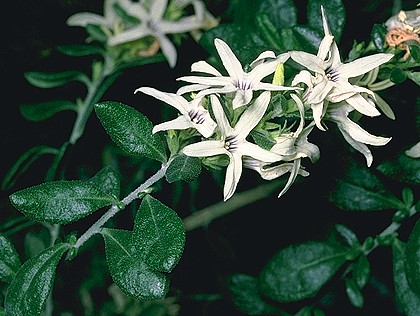 Photo: M. Fagg © ANBG |
 Photo: M. Fagg © ANBG |
 Line drawing by M. Perkins (from L.Haegi, unpubl. thesis). |

Synonymy
Cyphanthera tasmanica Miers, Ann. Mag. Nat. Hist. ser. 2, 11: 377 (1853)
Anthocercis tasmanica (Miers) J.D. Hook., Fl. Tasmaniae 1: 289, t. 92 (1857).
T: `Van Diemen's Land', Tas., Gunn 1992; syn: HO, K, NSW; Kelveden, Great Swanport, Tas, Backhouse s.n.; syn: K.
Description
Erect shrub to 4 m, grey-green. Branches densely to moderately granular-tomentose with stellate-dendritic, non-glandular hairs and scattered glandular hairs.
Leaves elliptic, almost sessile, 15–30 mm long, 4–9 mm wide, sometimes larger, tomentose.
Inflorescence panicle-like, dense, leafy; pedicels 2–9 mm long. Calyx 3.5–7 mm long, tomentose. Corolla 10–15 mm long, pubescent, creamy-white, the striations purplish; lobes ovate-truncate, 5–9 mm long. Stamens 2–4 mm long.
Capsule more or less globose, 4–5 mm diam. Seeds 2.5–3.5 mm long.
Distribution and ecology
A rare species endemic to the east coast of Tas. and adjacent offshore islands. Occurs on steep, rocky, exposed coastal sites.
Common name
Tasmanian Ray Flower
Notes
Pharmacology: A discussion of the tropane alkaloids which occur in Cyphanthera and other Anthocercideae can be found in Griffith & Lin (2000).
Ref: W.J. Griffin & G.D. Lin (2000). Chemotaxonomy and geographical distribution of tropane alkaloids. Phytochemistry 53: 627–628.
Selected specimens
Tas.: Kelvedon, 13 Nov. 1972, A. Himson s.n. (HO); Kelvedon, Dec. 1975, A. Himson s.n. (ADW 51136); Cygnet River, F. Mueller s.n. (MEL 70245).
Derivation of epithet
From tasmanica, a reference to the type locality of the species.
Images and information on web
Coloured illustrations of this species can be seen in
- Hunt, DR & King, C (1978). Curtis's Bot. Mag. 182(2): tab. 762 (as Anthocercis tasmanica)and in
- Stones, M. & Curtis W. (1975). Endemic Fl. Tasmania 5, t. 199 (as Anthocercis tasmanica). The latter has illustrations of all of the plant's parts.
A photograph and information can be accessed on the website of the Tasmanian branch of the Australian Plants Society at www.apstas.com/sgaptas-springflowers6.html and another photograph of this species in the Royal Tasmanian Botanical Gardens by Nuytsia@Tas can be seen at http://www.flickr.com/photos/38709689@N00/2748434843/
Plant status (if any)
Classified as Risk Code 3RCa (Briggs & Leigh, Rare or Threatened Australian Plants, 1995).
Not listed under the Commonwealth EPBC Act but regarded as Rare under Tasmanian legislation. For a down-loadable fact sheet see www.dpiw.tas.gov.au/inter.nsf/Attachments/SSKA-72Z23Z/$FILE/Cyphanthera%20tasmanica.pdf